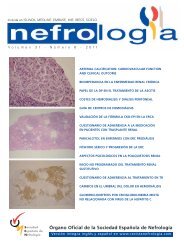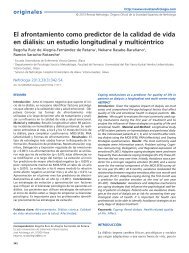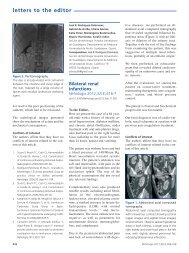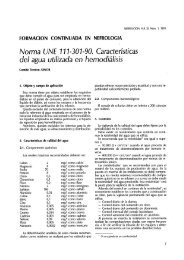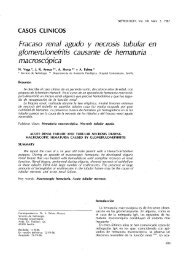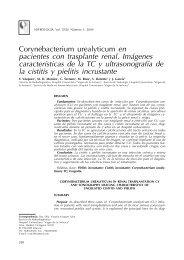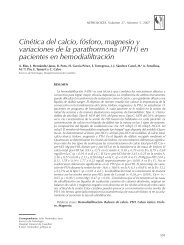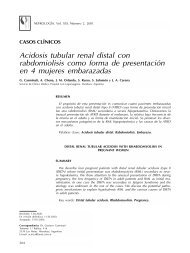PDF Número - NefrologÃa
PDF Número - NefrologÃa
PDF Número - NefrologÃa
You also want an ePaper? Increase the reach of your titles
YUMPU automatically turns print PDFs into web optimized ePapers that Google loves.
Supranee Kongkham et al. Alpha Tocopherol Prevent CIN in Rats<br />
originales<br />
lowing radiographic procedures. It has been reported that the<br />
prevalence of CIN may occur in 1 to 6% of hospitalized patients.<br />
1 It is especially the case that incidences of this condition<br />
may rise as high as 50% in patients at high-risk for such<br />
disorders as renal impairment and dehydration, diabetic<br />
nephropathy, volume depletion, hypercholesterolemia and<br />
congestive heart failure. This 50% incidence rate has also<br />
been seen in elderly patients, as well. 2,3 Also, high-volume administration<br />
of contrast exposure, contrast osmolarity and the<br />
concomitant use of medication have been indicated as risk<br />
factors of CIN. 4,5<br />
The pathophysiological cellular mechanism of the development<br />
of CIN remains unclear. The hypothesis has been proposed that<br />
the radiocontrast agents can generate reactive oxygen species<br />
and cause a decreased renal blood flow and induced renal arterial<br />
vasoconstriction. Such disorders would lead to ischemic tubular<br />
injury and can be the cause of direct tubular toxicity. 6 A<br />
number of animal-model investigations have suggested that oxidative<br />
tubular stress plays a substantial role, as supported by<br />
contrast agents-induced lipid peroxidation. 7<br />
In clinical examinations, many types of prophylaxis have been<br />
used in an attempt to prevent CIN. While hydration with isotonic<br />
saline before and after exposure to contrast agents is the<br />
standard practice, a substantial proportion of patients at risk<br />
continue nonetheless to be CIN. 8,9 Other agents such as<br />
dopamine, captopril, theophylline, atrial natriuretic peptide<br />
and calcium channel blockers are also ineffective. 10 An additional<br />
regimen such as the N-acetylcysteine (NAC) was used. 11<br />
Its properties are antioxidant and have the effect of a reactive<br />
oxygen radical scavenger; however, many clinical studies that<br />
assess the prevention of CIN have reported mixed results.<br />
Vitamin E, particularly in the form of alpha tocopherol, has<br />
been proposed for the prevention or treatment of numerous<br />
health problems 12 by reliance on the vitamin’s lipophilic antioxidant<br />
and anti-inflammatory properties. 13 In particular, it<br />
has been found to be the most efficient in scavenging peroxyl<br />
radicals for the protection of lipid peroxidation in cell<br />
membranes against oxidative damage. Vitamin E supplementation<br />
has been found to be protective against oxidative stress<br />
as, for example, in preventing cisplatin-induced acute renal<br />
failure 14 and in protecting aging kidneys for ischemic ARF 15 .<br />
Therefore, alpha tocopherol may assist in the treatment of<br />
CIN by scavenging oxygen-free radicals. A recent report in<br />
the clinical pilot study by Tasanarong and colleagues 16 has<br />
shown that the administration of vitamin E in CKD patients<br />
before coronary angiograph procedure provides a protective<br />
effect against CIN. In this clinical study, subjects in a<br />
prospective, randomized, double-blind placebo-controlled trial<br />
were randomized for supplementation with 525IU of Vitamin<br />
E or placebo, at 48h, 24h and in the morning before the<br />
coronary procedures. It has been found that 23.08% of CKD<br />
patients were given the placebo, while, quite interestingly,<br />
only 5.88% of CKD patients supplemented with vitamin E<br />
Nefrologia 2013;33(1):116-23<br />
had developed CIN, respectively. However, studies on the potential<br />
effects of vitamin E in CIN are not sufficient in either<br />
aspect of functional and histological changes in the kidneys.<br />
The purpose of this study was to investigate the benefit of antioxidant<br />
vitamin E in its preventive effect on CIN in rat models<br />
and to examine the preventive effect of difference doses<br />
of vitamin E on CIN.<br />
MATERIAL AND METHODS<br />
Chemicals<br />
Thiobarbituric acid (TBA), 2, 2’-azinobis (3-ethylbenzothiazoline-6-sulfonic<br />
acid) diammonium salt (ABTS), Trolox and<br />
all other chemical reagents were purchased from Sigma-<br />
Aldrich (Singapore). The low-osmolar, nonionic contrast.-<br />
media agent (Iopromide) was obtained from Schering AG<br />
(Germany). Vitamin E (alpha-tocopherol) was provided by<br />
Pharma Nord Aps (Vejle, Denmark).<br />
Animals<br />
Adult male Sprague Dawley rats obtained from the National<br />
Animal Center were used. All experiments were approved by<br />
the Animal Ethics Committee of the Faculty of Medicine,<br />
Thammasat University. All rats were housed in a temperaturecontrolled<br />
room (24 o C±1 o C) and were given standard food pellets<br />
and tap water until they weighed 250-300g, prior to the induction<br />
of CIN. The doses of vitamin E used in this study were<br />
determined on the basis of the several published studies that<br />
demonstrated these concentrations to be effective dose levels<br />
for the decrease in lipid peroxidation and oxidative renal injury<br />
in experimental animal models. 17,18 Vitamin E was reconstituted<br />
in 1% Tween80 in PBS. Rats were divided into six groups<br />
of 6-8 animals to each group as follows: Group1, control rat<br />
administered 1 ml of 1% Tween80 in PBS (control); Group2,<br />
contrast media (CM), 250 or 500mg/kg/day of vitamin E given<br />
to rats in group3 (250 mg Vit E) and in group4 (500mg Vit<br />
E), respectively. Rats administrated with 250 or 500mg/kg/day<br />
of vitamin E followed by CM injection were defined as group<br />
5 (250 mg Vit E+CM) and as group6 (500mg Vit E+CM), respectively.<br />
The animals were orally administered with antioxidant<br />
for 5 days, and then rats in Group2, Group5 and Group6<br />
received contrast medium on the next day. At the end of the<br />
study (24h after CIN induction), all animal test subjects were<br />
euthanized by inhalation of ether anesthesia.<br />
Induction of CIN in Rats<br />
CIN-induced rats were subjected to CIN protocol as described<br />
by Agmon et al. 19 Briefly, pentobarbital sodium<br />
(60mg/kg) anesthesia by intraperitoneal injection was fol-<br />
117



